Varroa resistance conference 2024
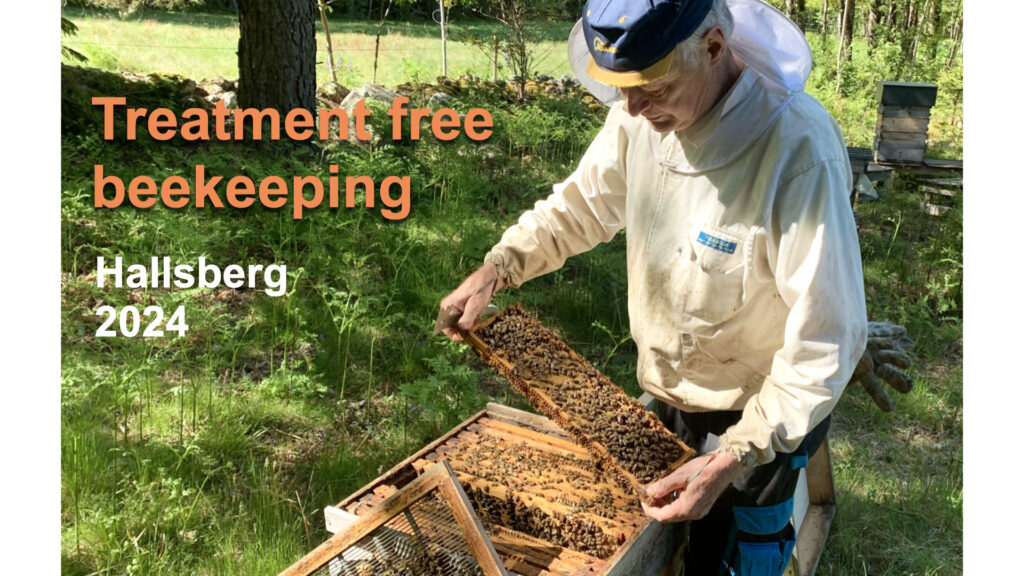
For the scientist, varroa resistance is complicated – for the beekeeper it is simple
For many years, we in Hallsberg have worked to develop varroa resistant/treatment free bees. 9 years ago, the first bee colonies became treatment-free. Then the entire local association began to invest in this direction. We now invited beekeepers from other places who were interested in our annual inspiration meeting. In recent years, we have had lecturers who were completely treatment-free, from Sweden, Finland, Norway and in 2024 the well-known Professor Stephen Martin from the UK.
The harvests did not get smaller, the swarming tendency did not get bigger and the temperament did not get worse because of our breeding focus. When the dominance of good drones was high in our area, it became quicker to get more bee colonies treatment-free.
2020 was the last year when a small part of the approximately 300 bee colonies in the center of the area with our bees received a small varroa treatment. A little closer around the mating site, there are about 80 colonies of said 300. Including these 300, in a slightly larger area there are about 700 colonies of our treatment-free bees.
On the website: https://www.elgon.es under the headline Gradual resistance, you can read about our breeding efforts in Hallsberg. I had planned to talk about this at the conference in november 2024, but there were so many questions after the presentations that I chose to refer to the website and give my presentation at next year’s conference. Prof. Joachim de Miranda from SLU attended the conference and helped answer some questions.

New initiatives for treatment-free apiaries
Every year for the last few years, beekeepers have acquired some splits or colonies from here. Some of these beekeepers have made an effort to place these newly acquired colonies 2-3 kilometers from other colonies. One of these had an apiary that’s treated “too close”, but it has been going well for several years with the treatment free bees and low winter losses.
At the conference, three beekeepers described this type of investment they have made this year.
Kenth Evertsson is chairman of Örebro County Beekeeping District and Västernärkes Local Bee Association. He tested two of his most promising apiaries as treatment-free in 2023-2024. In spring -24, the amount of varroa was very low. One colony had 0 mites with the Alcohol wash Varroa shaker. That colony and 3 splits from Hallsberg formed 2 new apiaries near Susanna Kivling’s treatment-free apiaries in Viby (the western part of Hallsberg). The area with treatment-free bees is growing.
Ylwa Alvarsdotter from the northern town of Örnsköldsvik (who hunts foreign chemicals in the environment in her professional work) acquired 3 splits from Hallsberg to a sufficiently isolated TF (Treatment Free) apiary. The apiary is planned to be used as a mating site for bee queens. Two other local beekeepers there acquired TF queens. The future is exciting.
Egon Andersson in Mölnlycke (western part of Sweden) is a well-known buckfast profile in Sweden. He has convinced the local association to invest in TF bees. They have acquired 3 splits from Hallsberg. They have bred many queens from these and from 2 broodframes with recently hatched worker eggs which they brought home early in the season. Most virgin queens were mated in the mating apiary in Hallsberg. A large area is being formed in Mölnlycke with TF bees. One of the aims is to use this area as a mating site for treatment-free bees. Mölnlycke bee association have support from the Swedish Board of Agriculture.
Veteran in varroa resistance
Per Ideström is a veteran in the field. He has made efforts for varroa resistant bees for many years. He has been a board member of Swedish Beekeeping Association and been its representative in the EU. He has now had treatment-free bees for 12 years, two average apiaries in western Sweden. In the fall of 2024, he checked the natural downfall during a week. Between 0-3 mites per day on average.
In one of his two apiaries that was close to an apiary that was treated, the downfall during a week in early October was a lot more than the figures given than the 0-3 mites. In that apiary, the natural downfall was also measured during one week in late October. By then, the downfall had decreased sharply to the above-mentioned 0 to 3. Per’s bees evidently cleaned out mites that was added by reinvasion from the neighbor’s bees. Strong resistant bees can apparently cope with this.
One of the beekeepers in Hallsberg
Radim Gavlovsky produces brood, queens and queen pupae for the Hallsberg Association and other interested parties. He pointed out that it is easy to reduce the use of pesticides against varroa in case of increased resistance when using thymol as we did in Hallsberg. Follow the link to the website at the beginning of this article. Make sure that the bee colonies have plenty of feed for the winter and coming spring. This ensures a good wintering. We have found that simple wooden boxes without insulation work well for bee colonies.
Björn Gustavsson, Swedish Board of Agriculture

We are pleased that Björn Gustavsson from the Swedish Board of Agriculture appreciated the participation in our conference. He described the task of the Swedish Board of Agriculture as the “executive body” of The Swedish Parliament out to the people. In our case, beekeeping, bees and beekeepers. The rules are there to help us all. He presented work they are involved in and how they support different projects, such as mating sites for treatment-free bees.
Keynote speaker Professor Stephen Martin
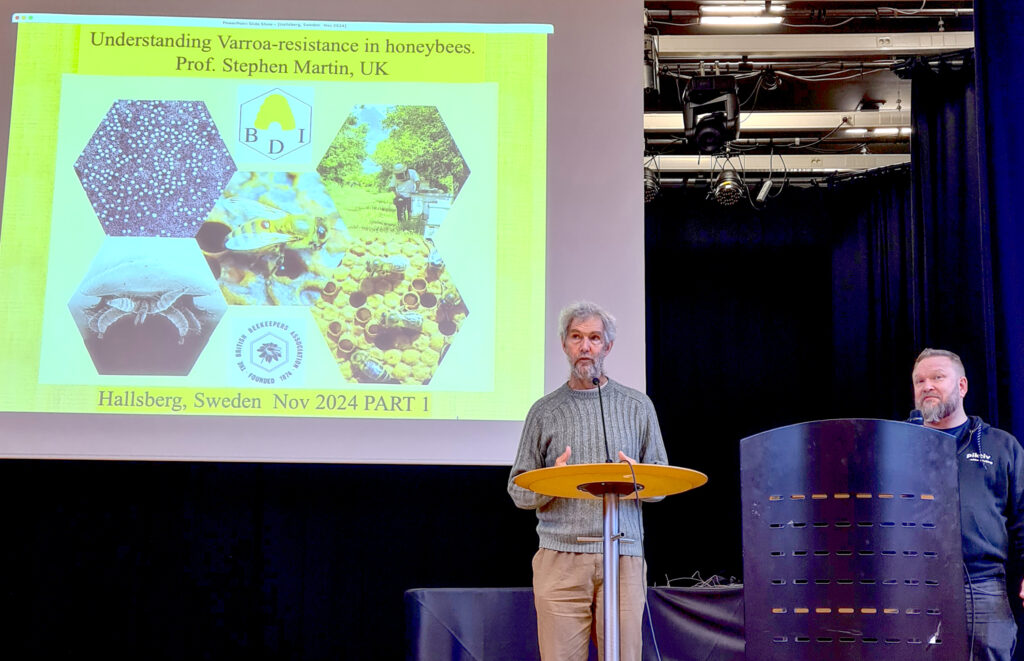
The keynote speaker this year was Professor Stephen Martin from England. It was a great privilege to hear him speak. He has extensive experience and is a recognized authority on bees, wasps, ants, termites and genetics. He lectures all over the world and guides and helps students in their research. He is like a living encyclopedia.
A few days before the Hallsberg visit, he was with Dr. Ralf Büchler in Germany, giving a talk at a varroa resistance conference. For a month before that conference, he was in China at a university helping the bee department there to research varroa resistance.
In the case of varroa resistance, he has collected data from different resistant bee populations in different parts of the world, South America, South Africa, Cuba, Hawaii (Oahu), Wales, UK, etc. What is common to all resistant bee populations is increased recapping (re-capping of capped brood cells that’s been prematurely uncapped and opened). It is a hygienic trait.
Recapping is one of the characteristics of varroa resistant strains of bees. Mapping how different varroa resistant traits work and interact is complicated. We are grateful researchers are doing this.
He emphasized that it is easy for beekeepers to develop resistance in their bees, without knowing exactly how this works. Three easy guidelines for the beekeeper.
– A. Keep track of how much varroa there is in the bee colonies and select those for breeding with the least amount of mites.
– B. Weed out the queens whose colonies have the most mites and are in the worst conditions.
– C. As a result, the treatment of bee colonies against varroa decreases as resistance increases.
Around 100 beekeepers in North West Wales have been treatment-free for many years, completely dominating the area. In the UK as a whole, just over 20% of beekeepers are treatment-free. Outside North West Wales, most treatment-free beekeepers in the UK are not isolated from treating beekeepers that use varroa treatments. Yet not having to treat seems to work for many.
Stephen Martin, together with some colleagues, runs a website with tips for treatment-free beekeepers: https://www.varroaresistant.uk
Comparison between countries
When Stephen Martin visited Dr. Ralf Büchler, they compared the different strategies used by beekeepers in different countries. In Germany, a lot of effort has been put into selecting for several different straits at the same time, temper, yield, tendency to swarm, varroa resistance. A lot of time is spent on developing ratings for the different traits. The number of treatment-free beekeepers compared to the UK is small.
In the UK there is very little such work as is done in Germany. Queen rearing is not extensive. Yet there is much progress in varroa resistance. So for beekeepers, this breeding work is not complicated, rather simple, Stephen Martin pointed out.
Is the genetics of the queen or the drones more important?
Stephen Martin has also conducted studies on whether the queen’s genetics or those of the drones have the greatest impact on breeding success in terms of varroa resistance. It seems that the queen matters most, i.e., at least in the short term, the queen’s daughter queens have the most impact on the resistance of their colonies, as it may seem, regardless of how they are mated. The resistance may differentiate in the following generations.
So beekeepers, why not set up a project (small at first) to increase varroa resistance in your bees!
The Hallsberg method for varroa resistance
The Hallsberg method is simple. It comes in two basic variants.
– 1. gradual resistance
– 2. no varroa control at all
The method is described in more detail at https://www.elgon.es under Gradual resistance.
In No 1, thymol is used as a miticide, with increasingly smaller amounts as resistance in the bees increases. When only a small amount, about 5 grams, is used annually at the end of the summer, pesticide use can be stopped.
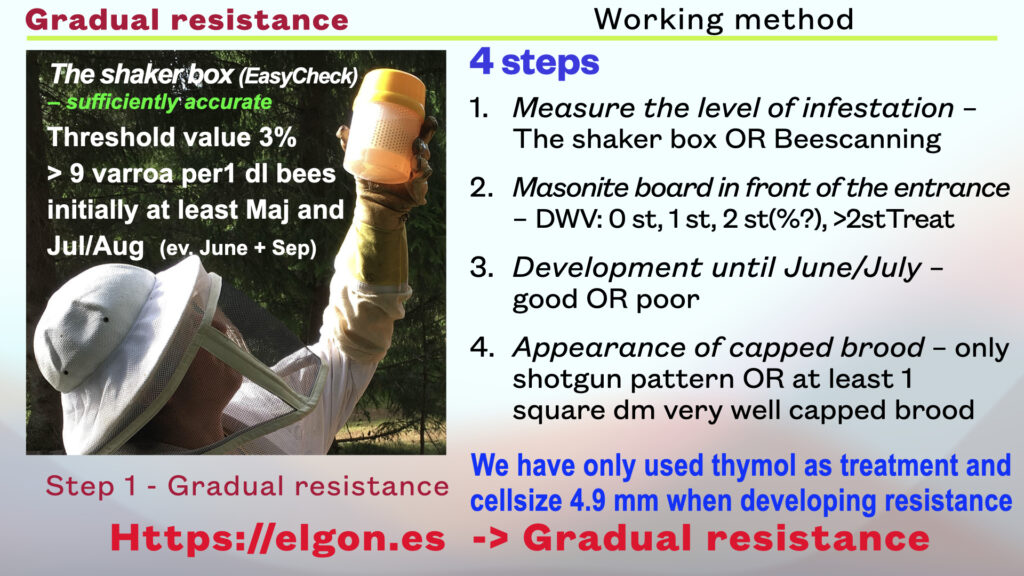
No. 2. can be chosen at any time in the process of increasing varroa resistance.
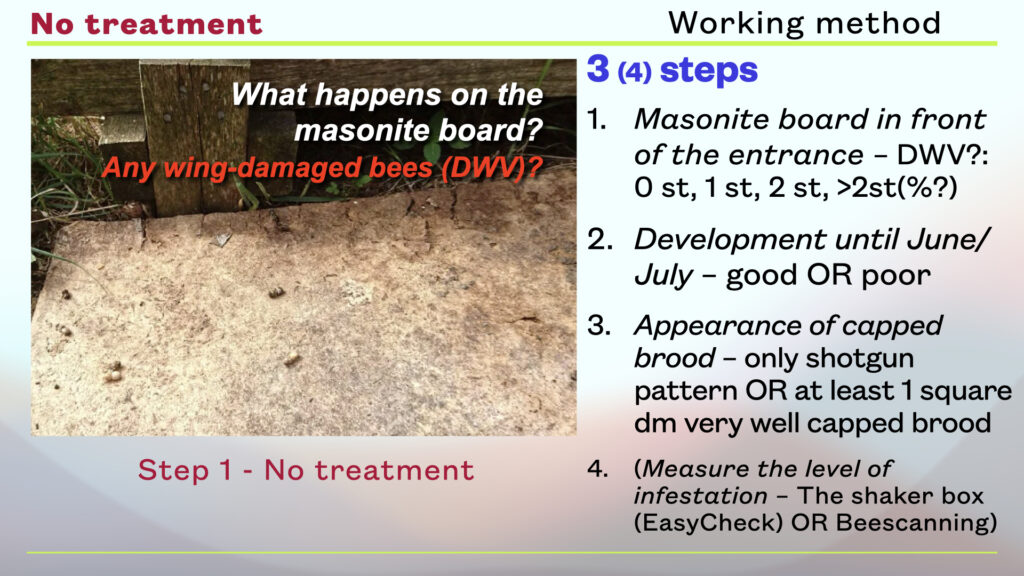
You can start with bees that have never been selected for varroa resistance. It is better, of course, to start with bee colonies that have made some progress. It is best to start with 2-3 treatment-free colonies/layers from a treatment-free beekeeper and place them in an apiary with only these 2-3 colonies.
To minimize losses of colonies, avoid disturbance of neighboring beekeepers’ bees from your bees and avoid disturbance of your bees from other beekeepers’ bees, aim for at least 2-3 km (1-2 miles) distance between your project apiary(ies) and other beekeepers’ bees.
However, it can work well with less favorable conditions. One beekeeper with 3 bee colonies that were almost treatment-free, had just over 1 km to 10 colonies treated each year. Nevertheless, his more resistant bees could be expanded to more colonies and kept treatment-free with low winter losses.
Start project apiaries with only 2-3 colonies, also to minimize problems. Feel free to increase the number of colonies a little in the coming years.
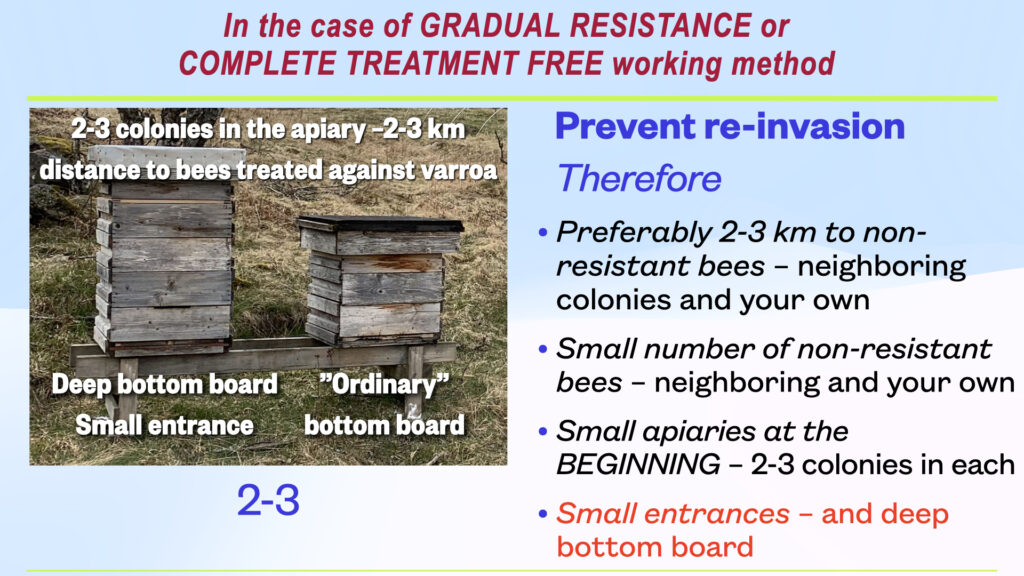
Replace queens in and/or remove poorly performing colonies.
Make splits from the best colonies. Let them produce their own new queens themselves. Let those mate in a project apiary and stay in it, or in a new project apiary aimed to be varroa resistance.
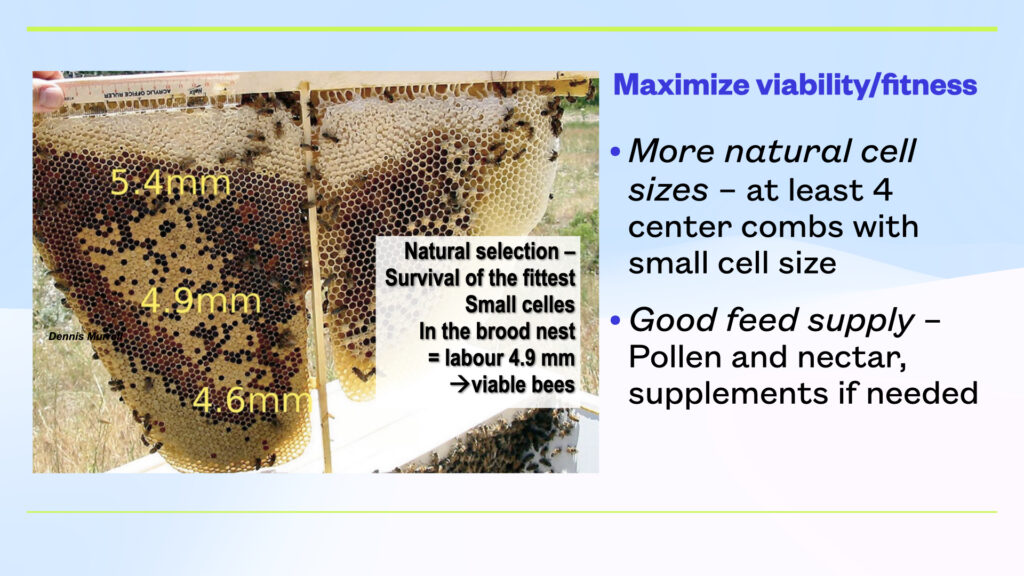
Use as small a cell size as possible, at least 5.1 mm, preferably 4.9 mm in at least the 4 middle frames of a brood box. If the bees can choose, they will make varying cell sizes, smallest near the entrance and in the center of the brood nest. Experiments have shown that bees born in smaller cell sizes have a greater hygienic ability. Hygienic traits are prominent in varroa resistance. Not all kind of hygienic traits have an effect on varroa resistance, although they do on brood diseases. All hygienic traits that have an effect on varroa resistance also have an effect on brood diseases. Breeding on low levels of mites increases varroa resistance. Let’s get started!